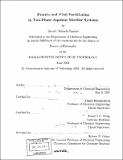Protein and viral partitioning in two-phase aqueous micellar systems
Author(s)
Kamei, Daniel Takashi, 1972-
DownloadFull printable version (23.46Mb)
Other Contributors
Massachusetts Institute of Technology. Department of Chemical Engineering.
Advisor
Daniel Blankschtein and Daniel I.C. Wang.
Terms of use
Metadata
Show full item recordAbstract
These changes included an expanded pattern of labeling and a large increase in the density of labeling. Changes were seen not only in primary auditory cortex, but also in other cortical fields that have not been studied before. In contrast, there was little change in brainstem (inferior colliculus, dorsal and anteroventral cochlear nucleus) labeling. Second, the effect of past sound exposure on brain response to sound was examined. After daily exposure to a sound, labeling evoked by that sound was markedly decreased in cortex, but not in brainstem. In two very different conditions, hearing loss and prior sound exposure, we found the same answer: cortical Fos labeling was highly changed, whereas brainstem labeling was more stable. The results suggest that the effects observed in cortex do not reflect subcortical changes and that the multiple fields of auditory cortex are malleable in ways that brainstem auditory nuclei are not. Competitive inhibition and partitioning studies were conducted to investigate possible attractive interactions between the C10E4 micelles and the tailspikes/capsids of bacteriophage P22 (model virus). These possible attractive interactions were investigated because they could counter the effect of the excluded-volume interactions. However, the attractive interactions between the bacteriophage P22 particles and the C10E4 micelles were found to be negligible. (cont.) An experimental study was also performed to examine whether all the micelle-rich and micelle-poor domains that are formed at the onset of phase separation are in their corresponding macroscopic phases prior to quantifying the viral concentrations in the two phases. In this study, the entrainment of micelle-poor domains in the top, micelle-rich phase was found to be the key factor influencing the partitioning behavior of viruses. In addition, a new theoretical description of partitioning was developed that combines the excluded-volume theory with this entrainment effect. Good agreement between the measured and the predicted viral partition coefficients was attained. It was therefore concluded that the primary mechanisms governing viral partitioning are the entrainment of micelle-poor domains in the top, micelle-rich phase and the excluded-volume interactions between the viruses and the micelles. Direction B centered around the less optimistic point-of-view that the viral partition coefficients could not decrease and approach the extreme viral partition coefficients predicted by the excluded-volume theory. However, even with the viral and protein partition coefficients that had already been achieved in the two-phase aqueous C10E4 micellar system, the virus was excluded more strongly than the protein into the bottom, micelle-poor phase. Accordingly, the volume ratio was varied in order to attain a 75% yield of lysozyme (model protein) in the top phase and a 97% yield of bacteriophage P22 in the bottom phase. (cont.) To further increase the yield of protein in the top phase, another mode of interaction was introduced to attract the protein into the top, micelle-rich phase. Specifically, a two-phase aqueous mixed (nonionic/ionic) micellar system was formed by the addition of the anionic surfactant SDS to C10E4. An experimental study was conducted to demonstrate proof-of-principle that two-phase aqueous mixed (nonionic/ionic) micellar systems could indeed be used to modulate both electrostatic and excluded-volume interactions between the proteins and the micelles. ...
Description
Thesis (Ph. D.)--Massachusetts Institute of Technology, Dept. of Chemical Engineering, 2001. Includes bibliographical references (p. 305-316).
Date issued
2001Department
Massachusetts Institute of Technology. Department of Chemical EngineeringPublisher
Massachusetts Institute of Technology
Keywords
Chemical Engineering.